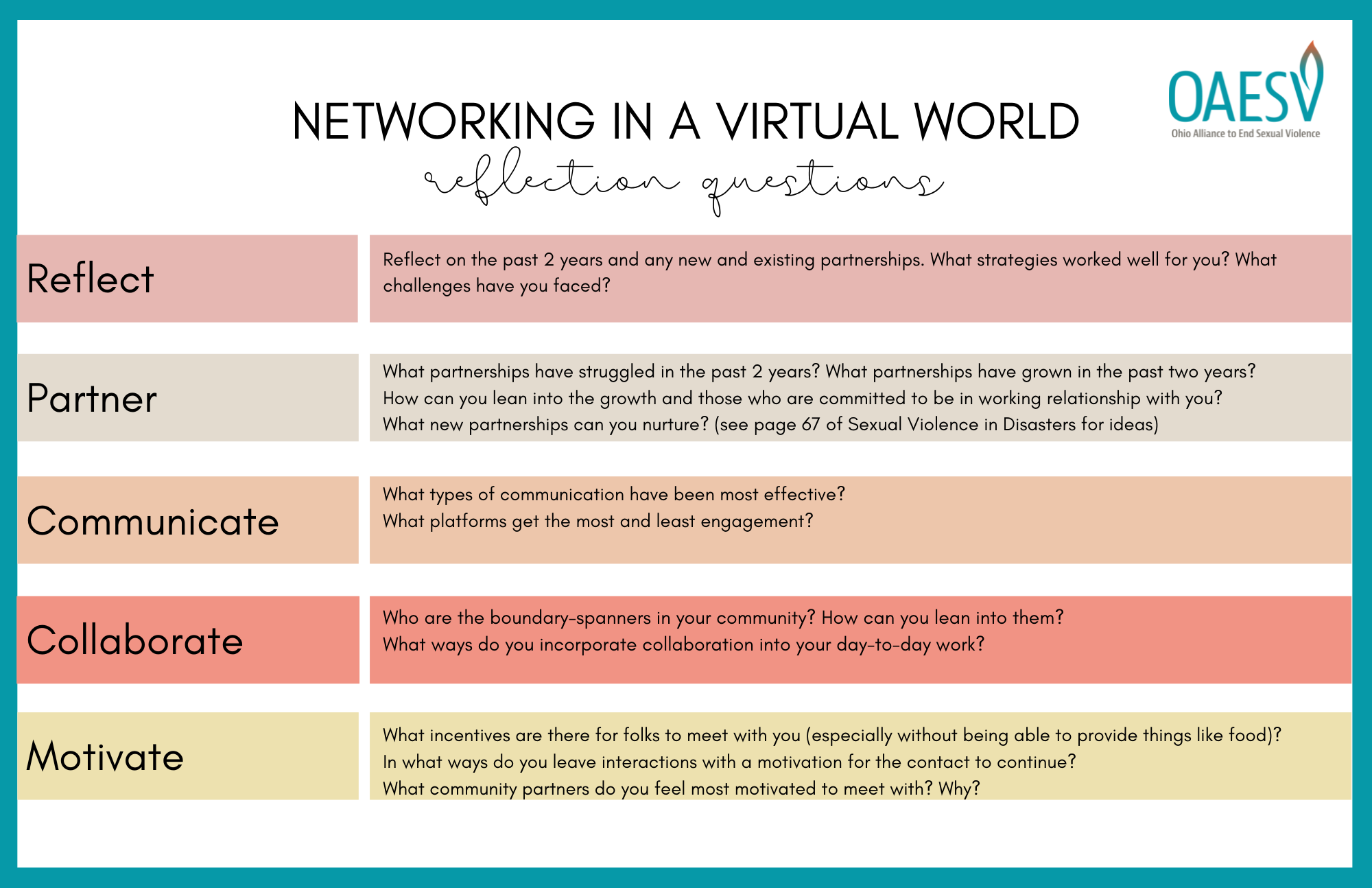
Networking in a Virtual World
In the past two years, the ways that we interact have changed drastically. Pre-pandemic, we had robust opportunities to network: tabling events, attending each other’s fundraisers, dropping by community partners’ offices, and in-person meetings filled with the possibility of catching up, connecting, and building strong working relationships. It’s felt a lot harder since then, hasn’t it?
We may feel like we are floundering as communication constantly changes, and yet not only do we persist, but we are also able to expand our networks in many creative ways. Increasing our technological presence creates opportunities for us to provide alternatives to transportation, utilize closed captioning/transcripts, and provide ways for some folx to feel safer and more confidential. We’ve also likely found ways to network and provide services safely without technology, such as mobile advocacy, mailers, print materials, PSAs, and creative partnerships. As we learn from the past two years, it’s vital that we center the ways that we’ve been able to increase accessibility and be intentional in who we are reaching and how so that our movement is equitable and serving those who are most impacted by sexual violence.
With that in mind, let’s explore some general tips for networking in a virtual world, and some SART leader-specific tips to create the most connection possible.
5 Ways to Network in a Virtual World:
- Be intentional about budgeting time to network. As you create your schedule and to-do list, make sure to hold time for relationship-building. Devote a certain day or time period to relationship-building activities (for instance, the time that you might normally be commuting to a community meeting), and consider establishing a regular monthly or quarterly meeting time with the relationships you want to nurture.
- Attend virtual events with a purpose. Take some time during your virtual meeting, training, or event to note who is present who you would like to connect with and anything that might be a good way to initiate contact, such as shared interests/goals, upcoming projects, or something they are seeking support on.
- Put thought into your follow up. Follow up after events or meetings with a phone call or email and connect with talking about the event or something you noted from them at the event. You can also get creative by sending a handwritten note, small gift, or an article; adapting coffee or lunch meetings to share coffee virtually or meet at a park to eat lunch; or even just show up to support an event they talked about. You may also consider asking a mutual connection for a warm referral.
- Be present, engaged, and professional. Participate in as many meetings as you can and engage in discussions to leave an impression. If someone says something that sticks out, be vocal about it! Mention it in your discussion or the chat. Keep your camera on if you can, but also make sure that your space and appearance reflects your program and mission.
- Combat Zoom fatigue. We know that it is harder to stay focused and active throughout our days of Zoom meetings. Consider turning off your self-view and avoid multi-tasking during meetings. If you’re facilitating a meeting, consider co-facilitating with a community partner or colleague so you can attend more to each person and create more connections. Additionally, consider setting meetings at 45-minute intervals so that you and your attendees have plenty of time to snack, grab some coffee or water, or use the restroom between virtual meetings so you can fully focus on the meeting at hand.
5 Ways for SART Leaders to Foster Connection in a Virtual World:
- Create an atmosphere of peer support. Providing mutual support can be a powerful connector. SART leaders can facilitate connection by connecting people during meetings, have attendees share contact information, and even create shared resources. Be boundary-spanners in your community, and identify others. Not only will this assist in multi-disciplinary interactions, but also increase feelings of trust and efficacy.
- Make meetings interactive and dynamic. Consider using icebreakers, discussion topics, breakout rooms, or dividing into subcommittees to make meetings more relational and lively. Be sure to also build in time to chat! Devote at least 5 minutes at the beginning or end of the meeting for small talk and relationship building.
- Connect in your day-to-day tasks. Outreach and networking aren’t mutually exclusive from other duties in our work. Often great working relationships come out of collaborating rather than working in silos. Sexual violence impacts nearly all areas of life: spiritual, emotional, physical, financial, legal social, and occupational to name a few. We can connect sexual violence and healing with many disciplines to utilize our shared goals. Collaborating on resources, inviting partners to co-facilitate trainings, Zooming in for a virtual in-service, or coordinating support for a survivor(with an informed release, of course) can be a way to holistically serve survivors and create valuable partnerships.
- Determine preferred types of communication. We have so many different platforms with which we can communicate that it’s helpful to get on the same page. Some disciplines may not have much of a chance to get to their email, and may prefer that you drop a note by their office or send a quick text. Others may prefer to phone or video calls. Be sure to understand what each individual prefers and can best access, and lean into their style of communication to increase your chances of a successful working relationship.
- Center collective care. I don’t think I’ve talked to anyone over the past 2 years that hasn’t felt completely overwhelmed. “Networking” can be put at the bottom of our to-do list when we are constantly responding to crisis and surviving a global pandemic, but when we reframe it as mutual support and showing up for each other in an incredibly difficult time, it becomes more about the relationship and less about the to-do list.
Ultimately, just as survivors are the experts of their own lives, you are the expert on yourself and your community. As we start off our networking, SART meetings, and services in 2022, it may be helpful to reflect on challenges that we can grow from and successes that we can celebrate from the last couple of years. Take some time to consider the questions below and share some answers in the comments so we can learn from each other!

Networking in a Virtual World Reflection Questions:
- Reflect: Reflect on the past 2 years and any new and existing partnerships. What strategies worked well for you? What challenges have you faced?
- Partner: What partnerships have struggled in the past 2 years? What partnerships have grown in the past two years? How can you lean into the growth and those who are committed to be in working relationship with you? What new partnerships can you nurture? (see page 67 of Sexual Violence in Disasters for ideas)
- Communication: What types of communication have been most effective? What platforms get the most and least engagement?
- Collaborate: Who are the boundary-spanners in your community? How can you lean into them? What ways do you incorporate collaboration into your day-to-day work?
- Motivate: What incentives are there for folks to meet with you (especially without being able to provide things like food)? In what ways do you leave interactions with a motivation for the contact to continue? What community partners do you feel most motivated to meet with? Why?
Sources and further reading:
Sexual Violence in Disasters from NSVRC
SARTs in Times of Crisis: Responding to Sexual Violence during COVID-19 from SVJI
Developing Motivation When Rebuilding a Team from SVJI
Re-Engaging the Team from SVJI
7 Tips for Networking in a Virtual World from Legally Balanced
Celebrating and Networking in a Virtual World from What MOVES Her
7 Ways to Make the Most of Networking in a Virtual World from Greater Houston Partnership
Networking in a Virtual World an Essential Skill for Success from Guided Insights
Tips for Effectively Growing your Network in a Virtual World from the American Bar Association
How to Build Real Relationships in the Virtual World from Forbes
Networking in a Virtual World from NC State University Jenkins MBA
